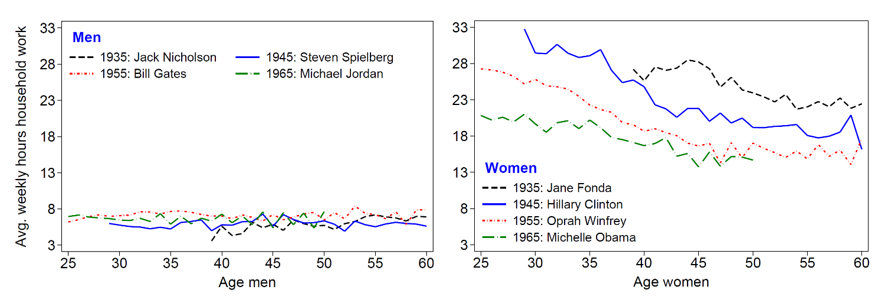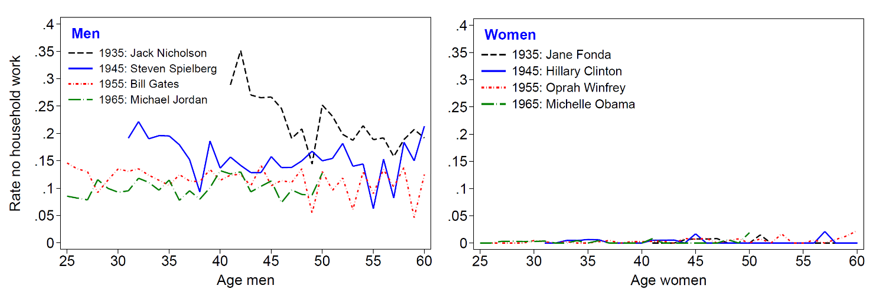
I draw data for multiple cohorts of American men and women in the Panel Study of Income Dynamics (the longest running longitudinal household survey in the world) and the Multinational Time Use Study to understand how married people use their time.
Women born in 1935, such as Jane Fonda, worked for pay for about 800 hours per year – 16 hours in a typical week. Women born ten years later in 1945, like Hillary Clinton, worked substantially more than the ‘average’ Jane Fonda, but less than women in later cohorts. The same pattern repeats over time: women born in 1955, like Oprah Winfrey, worked more than the ‘average’ Hillary Clinton while those born in 1965, such as Michelle Obama, work more than the ‘average’ Oprah Winfrey. While I use these names only for illustrative purposes, Michelle Obama has worked for pay for about 1500 hours per year, or 30 hours in a typical week, which is nearly twice as much as Jane Fonda – a large shift in women’s time use in only 30 years. Over the same period, married men reduced their work for pay by only a small margin.
Figure 1. Average annual hours of labour market work for men (L) and women (R)

Over the same time span, women reduced their non-paid work in and around the household (e.g. cooking, cleaning, and gardening) from about 30 hours per week in Jane Fonda’s cohort (1935) to 18 hours in Michelle Obama’s cohort (1965). This reduction is gradual over time, occurring little by little by each female cohort in-between. Their husbands step in to cover the household work ‘void’ only to a small extent. Men born in 1935, such as Jack Nicholson, spent about 6 hours per week on household work, while those born in 1965, like Michael Jordan, spent 8 hours. In addition, far fewer men in later cohorts do not contribute to household work at all compared to those in earlier ones (10 per cent for the `average’ Michael Jordan versus 25 per cent for the `average’ Jack Nicholson of the same age). Men in the middle cohorts are again `sandwiched’ in-between.
Figure 2. Average weekly hours of household work for men (L) and women (R)

Figure 3. Rates of absence from household work for men (L) and women (R)

Mothers and fathers increased the time they devote to children (not shown). In 1975, when parents in the 1945 cohort were raising their children, women spent about 11 hours per week caring for children under the age of five, while men less than three. Three decades later, in 2003, women spent 19 hours per week (a 72 per cent increase) while men nine hours (a 200 per cent increase). Parental time with children of older ages sees changes of similar magnitude. What may explain the combination of these large changes?
Making sense of the evidence
I develop a model to discipline the various time allocations in the family – paid work, household work, and childcare – and quantify the factors driving them. While the trends I summarised above primarily concern married individuals, the model also considers the possibility of divorce. There are two reasons for this. First, most of my data are from after the 1970s, a period when most couples in the US can divorce unilaterally. Second, the possibility of divorce influences the way individuals allocate their time in marriage. For example, a high probability of divorce induces individuals to accumulate financial and human capital as a means of insurance upon divorce (and paid work typically produces both types of capital); by contrast, a low divorce probability enables spouses to specialise in different time activities.
The model allows me to assess the importance of several underlying factors. Here I focus on two, perhaps the most prominent: the gender convergence in wages over the last decades — what economists call narrowing of the gender wage gap — and changes in women’s bargaining power in their households. While the gender wage gap is observed in the data (though not independently of individuals’ time use choices), women’s bargaining power is not. However, such power relates to women’s financial and family prospects if they divorce from their partner — what economists call ‘outside option’ — which have improved over time. Such improvement reflects on women’s relative bargaining power in their households, influencing how the spouses allocate their times.
Results over a slightly shorter period (1980-2010) suggest that as the gender wage gap gradually closes down in favour of women, women enter the labour market seeking full-time jobs. This mechanically reduces the amount of time they devote to household work while better technology at home (e.g. cheaper appliances and services) further facilitates this dynamic. As women accumulate work experience, their wages increase, further reinforcing this cycle and marginally “crowding out” their husbands in the labour market. At the same time, women’s improved bargaining power in the household results in a transfer of household work to their husbands that other factors alone, such as the narrowing wage gap or technological improvements, cannot generate. It explains men’s gradually larger involvement into chores and childcare.
Implications
The findings are suggestive of the likely implications of eliminating the gender wage gap. If men and women had similar wages, women’s rates of market work would tend to mimic men’s. The same applies to childcare, where men would further increase their involvement, and household work, where women would further reduce theirs. The increase in female work would be particularly strong in the childbearing years with women entering the labour market when they previously abstained.
The findings also have implications for how researchers think of women’s bargaining position in their households. Models abstracting from household work or childcare will likely not imply gains in women’s bargaining power over time because female leisure would appear to drop dramatically due to the big increase in women’s paid work. Models of family decision-making, which typically only model labour supply, must also account for these choices.
♣♣♣
Notes:
- This blog post is based on the author’s paper Wages and Family Time Allocations and follow-up work presented at the European Economic Association Annual Congress in 2019.
- The post gives the views of its author(s), not the position of LSE Business Review or the London School of Economics.
- Featured image by seagul, under a Pixabay licence
- When you comment, you’re agreeing to our Comment Policy
 Alexandros Theloudis is a post-doctoral researcher at the Luxembourg Institute for Socio-Economic Research and an honorary research associate in the Department of Economics at University College London. He works on household economics and lifecycle behaviour. He earned his PhD from University College London in February 2017.
Alexandros Theloudis is a post-doctoral researcher at the Luxembourg Institute for Socio-Economic Research and an honorary research associate in the Department of Economics at University College London. He works on household economics and lifecycle behaviour. He earned his PhD from University College London in February 2017.





